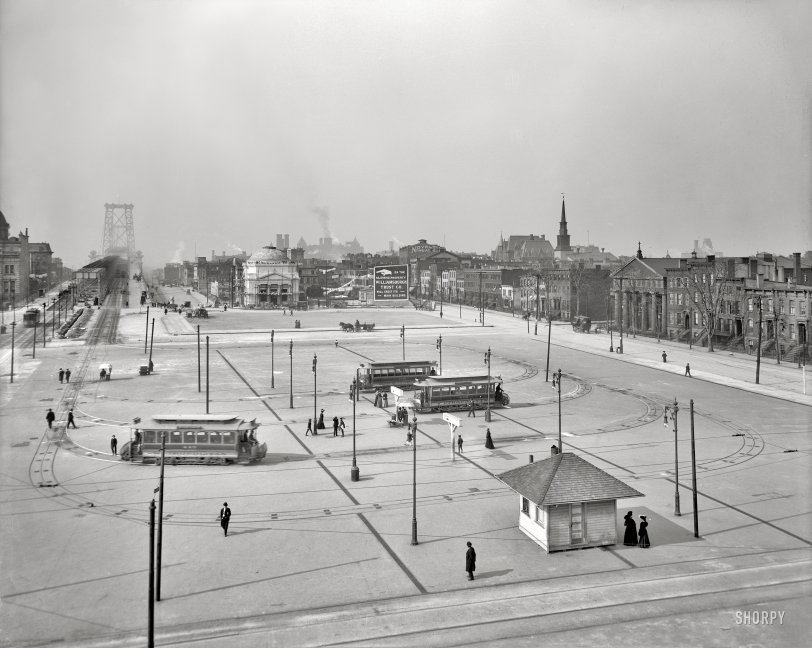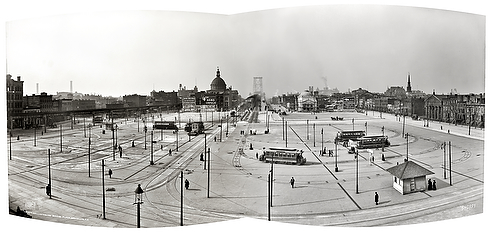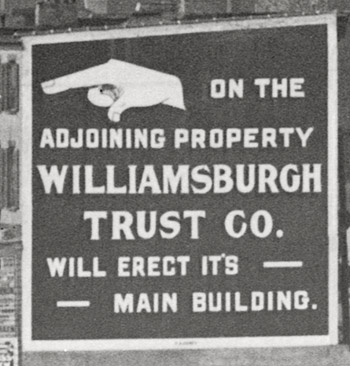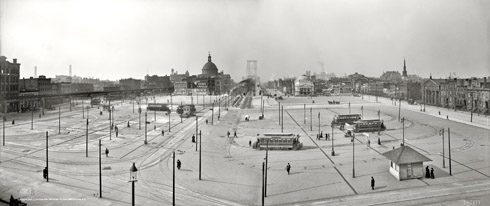


Framed or unframed, desk size to sofa size, printed by us in Arizona and Alabama since 2007. Explore now.
Shorpy is funded by you. Patreon contributors get an ad-free experience.
Learn more.

- Lofty addition
- In 1912
- Keenan Building
- Six years old
- Taken from the P.J. McArdle Roadway?
- It stood only 47 years
- Three track mind
- Incline to the right
- Reach for the sky, 1912 style
- No clean sweep
- Same Job Title, Same Face
- Sadly Lost
- Beautiful ...
- Where you get your kicks
- Aim High
- Pueblo Revival sisters
- Pueblo Neoclassicism
- Milk Man
- Regional dialect.
- Spielberg's inspiration
- Great Photo
- Loaf Story
- Do you still have the Rakes category?
- Could almost be a scene from the 1957 movie 'Hell Drivers'
- The Wages of Fear.
- Conspicuous by their absence
- Got Milk?
- All that aluminum
- No lefties
- Smoke 'em if you've got 'em
Print Emporium
Turnaround Time: 1906

Brooklyn, New York, circa 1906. "Williamsburg Bridge Plaza." The second half of this view. 8x10 inch glass negative, Detroit Publishing Co. View full size.
Another image stitching
This is an easy one - the photographer was careful to avoid introducing parallax error between the images. In the overlapping areas, note the relationship of nearer objects to ones behind - they are the same in both images. This makes it easier for the stitching application (PTGui 9.1.2) to apply the transformations.
The perspective breakdown in the foreground may be an issue of of choosing a cylindrical projection instead of rectilinear. The 'bananarama' effect isn't terribly disturbing IMHO.
I left this one uncropped so you can see the degree of warping necessary to get the foreground elements to align.

Columns
The building on the right is the former First Presbyterian Church, now the home of the community organization El Puente. I took a closer-up photo up it, complete with a circa 1910 view, on my blog.
Track Switches and Hatches
Switches would also be thrown by an employee on the ground; the fellow sitting under the umbrella looks to be controlling two switches with the levers before him. These were probably the switches to the inner loop and the second loop. The third switch was probably always set for the loop as the outer track looks too clean to see regular service. The trailing point switches on the way back to the bridge were likely spring switches that would be thrown by the cars' wheels passing through them and then spring back to the default position. The nice neat hatches were necessary for access to the conduit vault which would fill up with snow, ice, and debris such as tire chains. Conduit systems were expensive to build and a real pain to maintain.
Track switches
Street car track switches could be changed by the motorman by using a long pole that he carried in the car. That way he did not have to dismount or get out into the rain.
A Man's Home Is His Castle
I'm intrigued by the building on the right with the large columns. It seems so out of place among the apartments, like it could be a bank or some such business, but there is no signage that I can see. Is it someone's home?
[The House of God, judging by that cross on the roof. - Dave]
An old timer's memories.
The overhead wires are for the Brooklyn trolley system, which ran four or five routes over the bridge to an underground terminal at Delancey Street. The terminal is still in place, unused. The conduit tracks were used by the Green Line cars of Manhattan lines that had some service over the bridge also. My dad talked about taking the Madison Avenue streetcar from Brooklyn over the bridge eventually to Grand Central Station. Some ride for a nickel. He also made a few cents each day after school by helping to lead horse wagons over the bridge if the horses were nervous about the tight roadway and the noisy river traffic. Sometimes he would get treated to a free lunch at a saloon while the horses got watered and the owners got loaded up on beer for the return trip! Those wuz the daze.
You can also recognize the unfinished elevated train structure being built on the Bridge - still very active with two lines "J" and "Z".
I don't think there is any more shuttle bus service over either the Williamsburg or Manhattan bridges. Also no transit over the Brooklyn Bridge, which now is used only for automobile and foot traffic.
Incredible View
Those apartments on the right side of the photo had a front row seat on (I bet at times) a very busy part of the city.
Just a little old shanty nowhere near Shantytown
The small building was an office for the crews to get schedule changes, working supplies and most importantly for 'ahem' personal relief. Fares were paid after boarding the car.
Switches
Those don't look (to my untrained eye) like the switches on regular train tracks. How did the motorman turn onto a different set of tracks?
Hats and coats
Visit the scene today, and you'll still find men in hats and long black coats.
Lionel-like
At first glance the perfectly-spaced tracks, light poles, and recurring pattern of plates between the rails almost make you think you're looking at a giant Lionel train layout. The simple building at lower right (was it a ticket office?) only adds to the illusion of a toy train.
Makes me want to drag out the old electric train set this Christmas and try to duplicate the scene.
A playground
and a lot of highway. Many buildings still there.
In God They Trust
The Williamsburgh Trust Co. Main Building is indeed still standing at 185 S. Fifth Street, but it is now the home of the Holy Trinity Church of the Ukrainian Autocephalic Orthodox Church in Exile.
Its or It's
I believe the Williamsburgh Trust Company should erect "its" Main Building, etc.
Maybe a spot on the picture?
[Even back in 1906, the wily apostrophe was making trouble! - Dave]

I Trust
The Williamsburg Trust Main Building, a veritable temple to financial security, is still there. Nice subtle sign.
Panorama
A quickie photomerge of the two shots. Not perfect, but gives a good sense of the Plaza's scale.
[Excellent job! Interesting to note the difference in shadows. - Dave]
Yeah, the extreme angles of the two shots make for some bad perspective, particularly in the foreground where it totally breaks down. So the shadows appear to be going everywhere. :) -Steve
[I'd guess it's mostly because the sun moved between shots. - Dave]

























On Shorpy:
Today’s Top 5